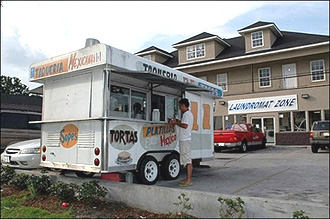 |
 |
 |
 Editorials | Issues | June 2007 Editorials | Issues | June 2007  
Latino Workers Changing New Orleans' Profile
 Agence France Presse Agence France Presse


| | A customer buys food at a mobile "Taqueria" in New Orleans. An influx of Latino workers from Mexico and Central America is radically altering the demographics of New Orleans. (AFP/Russell McCulley) |
Brass bands and jazz, crawfish po-boys and gumbo still rule in the French Quarter, where tourists flock in search of New Orleans cultural icons.

But venture outside the city's historic center, into neighborhoods being rebuilt after Hurricane Katrina hit in 2005, and the music of choice is more likely to have a Latin beat, while lunch is a stuffed tortilla.

An influx of Latino workers from Mexico and Central America is radically altering the demographics of New Orleans, a place that fiercely guards its traditions and often seems impervious to change.

The trend began shortly after Katrina ravaged the city in August 2005, precipitating a mass evacuation and destroying tens of thousands of homes.

Workers from Latin America poured into the region to help with the massive cleanup, and almost two years later thousands have stayed on.

Their presence is evident all over the city.

Groups of day laborers gather at intersections and outside home improvement stores looking for work on painting and construction crews.

Several Mexican restaurants have opened, and Latino families congregate on Sunday afternoons in neighborhood parks that were once largely unused.

"Prior to Katrina, we had a very stable, well-established [Hispanic] community here, but it wasn't growing, unlike other cities in the US," said Martin Gutierrez, director of the Hispanic Apostolate, a Catholic organization. "All of that changed after the hurricane."

Spanish radio stations and newspapers have expanded. The New Orleans Times-Picayune daily now runs an employment supplement in both Spanish and English.

And a section of eastern New Orleans that was once almost exclusively Vietnamese now sports grocery stores and other businesses catering to a growing Latino market.

The emergent Hispanic population has prompted the Mexican government to reopen the consulate, five years after it was closed because of a stagnating population, ending ties which went back to 1820.

Precise statistics are hard to come by, but Lisa Ponce de Leon, an aide to New Orleans Mayor Ray Nagin who oversees the city's international business development office, said the Mexican population alone could be as high as 70,000, up from about 15,000 before the storm.

"They feel very comfortable with the culture," she said.

"And Benito Juarez was exiled here a few times," she added, referring to the 19th century peasant who rose to become Mexico's most revered president.

But the demographic shift has not always been smooth. Shortly after Katrina, Nagin publicly expressed concern that the city would be "overrun with Mexican workers" who would take jobs from locals trying to return home.

And there was some local grumbling among displaced residents, who maintained that much-needed work should go first to people who live here, or those trying to move back.

But that has virtually died down.

Despite occasional frictions, the fact that Mexico has opted to reopen its consulate in the coming weeks indicates that the growing Hispanic population will be more than just a temporary spike, said Eugene Schreiber, managing director of the World Trade Center of New Orleans.

| 
 | |
 |



